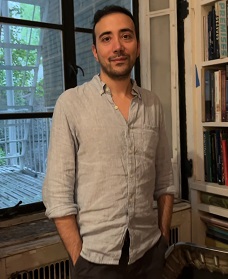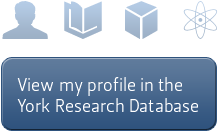Erhan Tamur
Lecturer in Art Curating
Visit Erhan Tamur's profile on the York Research Database to:
- See a full list of publications
- Browse activities and projects
- Explore connections, collaborators, related work and more
Profile
Biography
BA, Boğaziçi University; MA, Freie Universität Berlin; MA, MPhil, PhD, Columbia University
I am an art historian and curator specializing in the arts of Ancient Western Asia, particularly Mesopotamian and Anatolian art from the third to the first millennium BCE. I come to the University of York from The Metropolitan Museum of Art in New York, where I took part in the renovation and reimagining of the permanent galleries of the Department of Ancient Near Eastern Art. Between 2018–2022, I was employed at The Morgan Library and Museum in New York, where I co-curated the international loan exhibition “She Who Wrote: Enheduanna and Women of Mesopotamia (3400-2000 BCE).”
My work has been published in Res: Anthropology and Aesthetics, Forum Kritische Archäologie, The Journal of the Ottoman and Turkish Studies Foundation, and supported by grants and fellowships from the Center for Advanced Study in the Visual Arts (CASVA) of the National Gallery of Art in Washington D.C., The Mellon Foundation, The Sakıp Sabancı Center for Turkish Studies, and the German Academic Exchange Service (DAAD).
Research
Overview
Overview
- Ancient Mesopotamian and Anatolian art (particularly Sumerian art, Neo-Assyrian art and architecture, Hittite art, and Syro-Anatolian art in the Iron Age)
- Museum studies & the theory and practice of decolonization
- Archaeology and histories of colonialism
- Art historical and archaeological theory; continental philosophy
- The Ottoman Imperial Museum
Projects
My research has centred upon foregrounding underrepresented themes, sources, periods, and geographies, complemented by material, formal, iconographical, and contextual analyses of artworks. My current book project, Site-Worlds: Art, Politics, and Time In and Beyond Tello (Ancient Girsu), brings the art history of a paradigmatic archaeological site named Tello in modern-day Iraq from the third millennium BCE into the present by stressing the entanglement of multiple temporal frames spanning the artworks’ production, use, excavation, transportation, and exhibition. This project engages with critical and decolonial perspectives by not relying solely on western accounts about the “discovery” of this site, and integrates for the first time a wide range of local sources across time—from Sumerian inscriptions to Hellenistic sources; from Medieval Arabic texts to the nineteenth-century Ottoman archives. I demonstrate that this site was considered a place of memory and history for millennia, and counter the prevailing view that such sites were “discovered” in a terra incognita only after the arrival of the European and American excavators in the nineteenth century.
My work has also aimed to question and recalibrate art historical theories and methodologies that are often taken to be neutral and universal. For example, refuting the empirical basis for ethnic classifications of Syro-Anatolian orthostat reliefs (c. 1200–700 BCE), I redefined the concepts of “style” and “ethnicity,” and constructed an alternative categorization deriving from a re-evaluation of both ancient contexts and modern disciplinary histories. I also worked on the history of the disciplines of art history and archaeology, and investigated the longstanding impact of the concepts of immanence and stylistic influence in the field—with particular attention to the works of Meyer Schapiro and Hans Sedlmayr. In addition to my book project, I am currently undertaking several writing projects, ranging from exhibition settings in the Ottoman Imperial Museum to the work of the artist Burhan Doğançay; from the text-image dialectic in Sumerian art to the history of Mesopotamian archaeology from the eyes of an Ottoman government representative named Bedri Bey.
Since 2018, I have been active in the museum field and worked on the permanent collections of Ancient Western Asian art at the Metropolitan Museum of Art and the Morgan Library and Museum in New York. At the latter institution, I co-curated with Sidney Babcock an international loan exhibition titled She Who Wrote: Enheduanna and Women of Mesopotamia, 3400-2000 BC (14 October 2022–19 February 2023).
Research Projects
- Co-curator, She Who Wrote: Enheduanna and Women of Mesopotamia, Oct. 2022–Feb. 2023, The Morgan Library & Museum, New York.
- Archaeologist and Researcher, Mapping Mesopotamian Monuments Project sponsored by Columbia University Presidential Global Initiative and directed by Professor Zainab Bahrani.
- Researcher, “The Parallel Heritages: The Sorbonne and Columbia Collections of Antiquities,” 2019–20.
- Assistant Trench Supervisor, Tarsus/Gözlükule Archaeological Excavations (2009, 2010).
- Researcher, “Halet Çambel–Nail V. Çakırhan Residence in Arnavutköy: Historical and Socio-Cultural Study of an Ottoman Seaside Mansion of the Early Nineteenth Century,” Boğaziçi University, 2008–2009.
Research group(s)
In terms of fieldwork, I have attended archaeological excavations in Turkey, and been part of the international team for the Mapping Mesopotamian Monuments Project sponsored by Columbia University and directed by Professor Zainab Bahrani. This is an on-site documentation effort in Iraq and Turkey which seeks to counter the looting and destruction of the past, and the related dissociation of people from their diverse cultural histories.
Supervision
Supervision
Dr Tamur welcomes enquiries from potential doctoral candidates wishing to undertake advanced research in the fields of Ancient Western Asian art and museum studies.
Publications
Full publications list
Books
- She Who Wrote: Enheduanna and Women of Mesopotamia. New York: The Morgan Library & Museum, 2022 (with Sidney Babcock).
Peer-Reviewed Journal Articles
- “The ‘Discoverer’ and the ‘Informant.’” Forum Kritische Archäologie (forthcoming).
- “Specters of Influence: Meyer Schapiro and the New Vienna School,” RES: Anthropology and Aesthetics, vol. 75-76 (2021): 207–20.
- “Of Consuls and Steamers: Material Foundations of Colonial Archaeology in Late Ottoman Iraq,” Journal of the Ottoman and Turkish Studies Association, vol. 8, no. 1 (2021): 369–76.
- “Style, Ethnicity, and the Archaeology of the Aramaeans: The Problem of Ethnic Markers in the Art of the Syro-Anatolian Region in the Iron Age,” Forum Kritische Archäologie 6, no. 1 (2017): 1–72.
Peer-Reviewed Book Contributions and Catalogue Essays
- “Walls of Israel,” In Le Murs de Burhan Doğançay. Catalogue accompanying the exhibition “Le Murs de Burhan Doğançay” at the Musées d'Art et d'Histoire de Genève (23 September 2023–11 February 2024), edited by Bénédicte De Donker (Zurich: Scheidegger & Spiess, 2023), 38–49.
- “Signed, Sealed, and Delivered: Carving and Using Seals,” In An Educator’s Handbook For Teaching about the Ancient World, edited by Pınar Durgun (Oxford: Archaeopress, 2020), 112–14 (with Pınar Durgun).
Editor-Reviewed Articles
- “In Defense of ‘Incremental Change.’” Forum Kritische Archäologie 12 (2023): 66–68.
- “Goddesses, Mothers, and Rulers.” Expedition 64, no. 2 (2022): 34–43.
- “New Impressions and Future Directions: Columbia University’s Collection of Ancient Western Asian Seals.” EuropeNow 41 (2021) (with Majdolene Dajani)
- “Documenting Disappearing History: The Mapping Mesopotamian Monuments Project,” Mar Shiprim, online publication of The International Association for Assyriology (2020) (with Matthew Peebles)
Encyclopedic Entries
- The Mapping Mesopotamian Monuments Project (2018-ongoing): Hasankeyf (3191 words); Diyarbakır City Walls, Gates & Towers (2521 words); The Great Mosque of Diyarbakır (Ulu Cami) (2306 words); Gisgis Rock Relief (1185 words); Eğil Rock Relief (1461 words)
Reviews
- Review of Ian Verstegen, “The New Vienna School of Art History: Fulfilling the Promise of Analytic Holism” (Edinburgh: Edinburgh University Press, 2023),” Journal of Art Historiography 29 (December 2023): 1–12.
- Review of James F. Osborne, “The Syro-Anatolian City-States: An Iron Age Culture (Oxford: Oxford University Press, 2020),” Ancient Near Eastern Studies 59 (2022): 327–330.
Popular Articles (selected)
- “Kings, Dealers, and Librarians: The Story of a Statue of Shulgi,” The Metropolitan Museum of Art, Departmental Dispatch, 2023 (with Anne Dunn-Vaturi)
- She Who Wrote: Enheduanna and Women of Mesopotamia, ca. 3400–2000 BC (October 15, 2022 through February 19, 2023), The Morgan Library and Museum, blog post, 2021.
- From “Near East” to “Western Asia:” A Brief History of Archaeology and Colonialism, The Morgan Library and Museum, blog post, 2020.
Teaching
Other teaching
Undergraduate
- Objects in Focus (Curating)
Postgraduate
- Who Owns Antiquities? The Politics of Museology and Archaeology
- The Past in the Present: Time and Temporality in Ancient Art and the Modern Museum
External activities
Overview
Talks and Conference Presentations
- “Didactics and Their Discontents: The Tacit Coloniality of Museological and Archaeological Narratives,” Seventeenth International Conference on the Inclusive Museum, MuseumsQuartier, Vienna, September 13–15, 2024.
- “The Demise of the Asiatic Lion: A Tale of Travel, Archaeology, and Colonialism,” The Fifty-Fifth International Conference of the ARAM Society for Syro-Mesopotamian Studies: Orientalism and Western Travellers to the Levant, 1500-1950, The University of Oxford, July 8–10, 2024.
- Panelist, “Decolonizing European Museums,” 29th International Conference of Europeanists, Reykjavik, Iceland, June 27-29, 2023.
- Panelist, “Archaeology, Nation and Race: Confronting the Past, Decolonizing the Future in Greece and Israel,” The American Society of Overseas Research (ASOR) Annual Meeting, Boston, November 16–18, 2022.
- Guest Lecturer on “Teaching and Curating Ancient Art” for Professor Liat Naeh’s seminar “Art in Antiquity,” University of Toronto, online, August 10, 2022.
- “Site-Worlds,” Center for Advanced Study in the Visual Arts (CASVA), National Gallery of Art, Washington D.C., April 7, 2022.
- “From ‘Near East’ to ‘Western Asia:’ A Brief History of Archaeology and Colonialism,” The American Society of Overseas Research (ASOR) Annual Meeting, online, December 12, 2021.
- “Beyond the ‘Great Men’ of Archaeology: Tello and its Local Histories,” The Morgan Library & Museum, online, November 3, 2021.
- “Enheduanna: Authorship and Gender in Ancient Mesopotamia,” Fashion Institute of Technology, New York, October 6, 2021.
- Panelist, “Diskussionsrunde zum Begriff Vorderasiatische Archäologie,” [Panel on the term Near Eastern Archaeology], Freie Universität Berlin, online, February 18, 2021.
- “Of Consuls and Steamers: Material Foundations of Colonial Archaeology in Late Ottoman Iraq,” Voices of Emerging Scholars I: Politics of Archaeology, Columbia Global Centers, online, January 20, 2021.
- “Cylinder and Stamp Seals in the Columbia University Collections I and II” (with Majdolene Dajani), as part of the project Parallel Heritages: Humanities in Action. The Sorbonne and Columbia Collections of Antiquities, Columbia University, March 6, 2019 and the Sorbonne, Paris, 4–5 November 2019.
- “The Third Dimension: The Essential and the Redundant in Assyrian Reliefs,” Graduate Colloquium of the Department of Art History and Archaeology, Columbia University, November 2, 2017.


